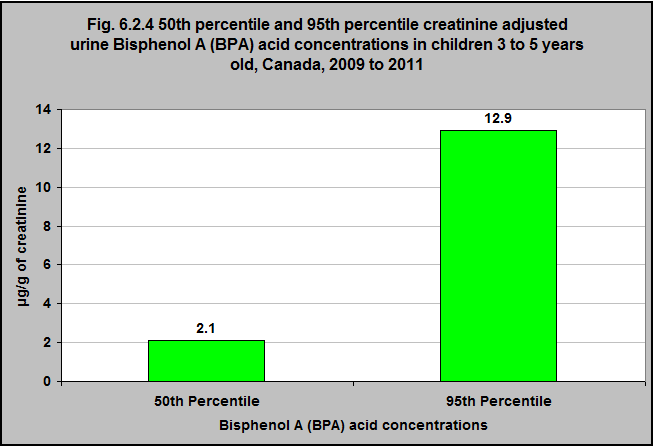50th percentile and 95th percentile creatinine adjusted urine Bisphenol A (BPA) acid concentrations in children 3 to 5 years old, Canada, 2009 to 2011

Note: This data reflects the children and youth whose concentration of the chemical met or surpassed the limit of detection. The 50th percentile concentration is the middle concentration, above and below which there is an equal number of values. The 95th percentile concentration is among the highest exposures.
Source: CICH graphic created using data adapted from Statistics Canada, Canadian Health Measures Survey, 2007-2009 custom runs.
Bisphenol A (BPA) is a man-made chemical known for its widespread use in consumer products.
According to the Canadian Health Measures Survey, for children and youth aged 3 to 5 in Canada, the median (50th percentile) and 95th percentile blood mercury concentrations in 2009-2011 were 2.1 µg/g of creatinine and 12.9 µg/g of creatinine, respectively.
Implications
In humans, BPA acts as an endocrine disruptor, interfering with the production and action of hormones. Hormones play important roles in physiological processes in the human body. Altering the effectiveness of hormones can have serious repercussions on behaviour, adolescent development, and reproduction. 1
There are other negative health outcomes that have been linked to BPA exposure. For many of them, the evidence is not conclusive. They include behavioural issues, altered neurodevelopment, mental health problems and increased risk of asthma, as well as prenatal effects on the fetus, including increased risk of spontaneous abortion, low birth weight and childhood obesity.2,3
Children and youth are exposed to Bisphenol A (BPA) primarily through the consumption of foods and beverages that have absorbed BPA from their packaging.2 They are also exposed to this chemical via contact with air, drinking water, soil, dust, and the use of a variety of products.
There are now regulations that limit the use of BPA in some consumer products, such as infant bottles. However, BPA is still present in some products available in Canada, potentially exposing children and youth to this chemical on a regular basis.
1United States Environmental Protection Agency. (2013). America’s Children and the Environment, Third Edition. https://www.epa.gov/sites/production/files/2015-06/documents/ace3_2013.pdf – accessed March 12th, 2017.
2Health Canada. (2013). Second Report on Human Biomonitoring of Environmental Chemicals in Canada: Results of the Canadian Health Measures Survey Cycle 2 (2009-2011). http://www.hc-sc.gc.ca/ewh-semt/alt_formats/pdf/pubs/contaminants/chms-ecms-cycle2/chms-ecms-cycle2-eng.pdf – accessed March 12th, 2017.
3Braun, J.M., Kalkbrenner, A.E., Calafat, A.M., Yolton, K., Ye, X., Dietrich, K.N., & Lanphear, B.P. (2011). Impact of early-life Bisphenol A exposure on behavior and executive function in children. Pediatrics, 128, 873-882. doi:10.1542/peds.2011-1335.
